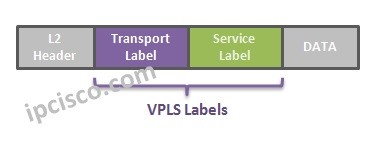- COURSES
- SPECIALS
- BLOG
- MEMBERS
- SHOP
- ABOUT
- ENROLL HERE

As we discussed in the MPLS articles before, for MPLS VPN we need labels. VPLS is also a MPLS VPN Service, so we need to use labels in VPLS too.
There are two MPLS Labels used in VPLS. These MPLS Labels are:

Again in the MPLS lessons, we have talked about P and PE routers. Briefly, P routers are the core MPLS routers that carries MPLS traffic and PE routers are the border routers of MPLS on which VPN Services are defined.
Outher Label (Transport Label) is the label that is used for label swapping during the transmission over service provider network. In other words, this label is used in the swap process of P routers.
Inner Label (Servise Label / VC Label) is the label that carries the original customer VPLS information. At P routers, it remains unchanged. But in PE routers this labels stripped and according to VPLS information inside, the packet is sent to the related service destination.
You can also view Nokia VPLS Configuration and Cisco VPLS Configuration Lessons.
What about VPLS Label Signalling? The signalling of these two labels are done differently.
In VPLS, Outher Label Signalling is done with LDP, RSVP or GRE protocols. This is the labelling mechanism that will occur inside the service provider network. Generaly, LDP is used for label signalling but to benefit from traffic engineering (RSVP-TE), RSVP is also used.
Inner Labels Signalling is done via T-LDP (Targeted LDP). For VPLS service, T-LDP session is very important. This is done with SDP configuration on Nokia Routers. This is the similar configuration as Pseudowire for Cisco products.
Here, there are two terms used in VPLS Mechanism. These terms are:
VC IDs is the identifier of the VPLS service from other services. For VPLS service, VC IDs (Virtual Circuit Identifier) must match on each end nodes for the same service.
Service ID is the number of the service. It is equal to VC-ID by default. Service ID is a local parameter. It is not need to configure same Service ID for both end.
Here, there is an important point. If you use Mesh-SDP, Service ID is equal to VC ID. If you use Spoke-SDP, VC ID is determined manually.
By the way, for label signalling, only one T-LDP is required between two nodes. The service numbers running on these system is not important. One T-LDP session works for all VPLS services.

In PE routers some switching activities are needed. To do this a Virtual Switch (VS) is defined in PE routers. And all the switching activities needed like MAC learning is done with this VS. You can think this like classical switch activities.
Leave a Reply